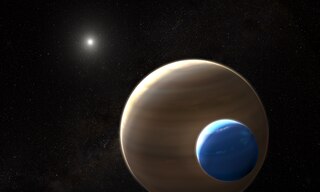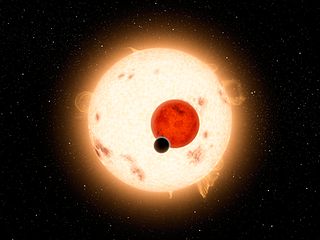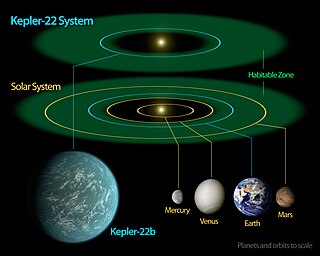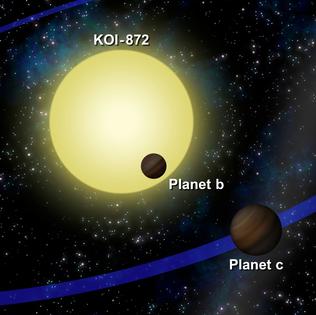Related Research Articles

An exomoon or extrasolar moon is a natural satellite that orbits an exoplanet or other non-stellar extrasolar body.

Any planet is an extremely faint light source compared to its parent star. For example, a star like the Sun is about a billion times as bright as the reflected light from any of the planets orbiting it. In addition to the intrinsic difficulty of detecting such a faint light source, the light from the parent star causes a glare that washes it out. For those reasons, very few of the exoplanets reported as of January 2024 have been observed directly, with even fewer being resolved from their host star.
This page describes exoplanet orbital and physical parameters.
HAT-P-11, also designated GSC 03561-02092 and Kepler-3, is an orange dwarf metal rich star about 123 light-years away in the constellation Cygnus. This star is notable for its relatively large rate of proper motion. The magnitude of this star is about 9, which means it is not visible to the naked eye but can be seen with a medium-sized amateur telescope on a clear dark night. The age of this star is about 6.5 billion years.

Kepler-9 is a sunlike star in the constellation Lyra. Its planetary system, discovered by the Kepler Mission in 2010 was the first detected with the transit method found to contain multiple planets.

Kepler-16b is an exoplanet. It is a Saturn-mass planet consisting of half gas and half rock and ice, and it orbits a binary star, Kepler-16, with a period of 229 days. "[It] is the first confirmed, unambiguous example of a circumbinary planet – a planet orbiting not one, but two stars," said Josh Carter of the Center for Astrophysics | Harvard & Smithsonian, one of the discovery team.

Kepler-22b is an exoplanet orbiting within the habitable zone of the Sun-like star Kepler-22. It is located about 640 light-years from Earth in the constellation of Cygnus. It was discovered by NASA's Kepler Space Telescope in December 2011 and was the first known transiting planet to orbit within the habitable zone of a Sun-like star, where liquid water could exist on the planet's surface. Kepler-22 is too dim to be seen with the naked eye.

Kepler-46, previously designated KOI-872, is a star located in the constellation Lyra. Observed since 2009 by the Kepler space observatory, it has since been found to possess a planetary system consisting of at least three planets and while it has a similar mass to the Sun (90%) it is significantly older at ten billion years.

Kepler-90h is an exoplanet orbiting within the habitable zone of the early G-type main sequence star Kepler-90, the outermost of eight such planets discovered by NASA's Kepler spacecraft. It is located about 2,840 light-years, from Earth in the constellation Draco. The exoplanet was found by using the transit method, in which the dimming effect that a planet causes as it crosses in front of its star is measured.
Kepler-102 is a star 353 light-years away in the constellation of Lyra. Kepler-102 is less luminous than the Sun. The star system does not contain any observable amount of dust. Kepler-102 is suspected to be orbited by a binary consisting of two red dwarf stars, at projected separations of 591 and 627 AU.

KOI-256 is a double star located in the constellation Cygnus approximately 575 light-years (176 pc) from Earth. While observations by the Kepler spacecraft suggested the system contained a gas giant exoplanet orbiting a red dwarf, later studies determined that KOI-256 was a binary system composed of the red dwarf orbiting a white dwarf.
Kepler-419c is a super-Jupiter exoplanet orbiting within the habitable zone of the star Kepler-419, the outermost of two such planets discovered by NASA's Kepler spacecraft. It is located about 3,400 light-years from Earth in the constellation Cygnus. The exoplanet was found by using the transit timing variation method, in which the variations of transit data from an exoplanet are studied to reveal a more distant companion.
Kepler-419 is an F-type main-sequence star located about 3,280 light years from Earth in the constellation Cygnus. It is located within the field of vision of the Kepler spacecraft, the satellite that NASA's Kepler Mission used to detect planets that may be transiting their stars. In 2012, a potential planetary companion in a very eccentric orbit was detected around this star, but its planetary nature was not confirmed until 12 June 2014, when it was named Kepler-419b. A second planet was announced orbiting further out from the star in the same paper, named Kepler-419c.
Kepler-1625 is a 14th-magnitude solar-mass star located in the constellation of Cygnus approximately 7,200 light-years away. Its mass is within 5% of that of the Sun, but its radius is approximately 70% larger reflecting its more evolved state. A candidate gas giant exoplanet was detected by the Kepler Mission around the star in 2015, which was later validated as a real planet to >99% confidence in 2016. In 2018, the Hunt for Exomoons with Kepler project reported evidence for a Neptune-sized exomoon around this planet, based on observations from NASA’s Kepler mission and the Hubble Space Telescope. Subsequently, the evidence for and reality of this exomoon candidate has been subject to debate.
Kepler-1625b is a super-Jupiter exoplanet orbiting the Sun-like star Kepler-1625 about 2,500 parsecs away in the constellation of Cygnus. The large gas giant is approximately the same radius as Jupiter, and orbits its star every 287.4 days. In 2017, hints of a Neptune-sized exomoon in orbit of the planet was found using photometric observations collected by the Kepler Mission. Further evidence for a Neptunian moon was found the following year using the Hubble Space Telescope, where two independent lines of evidence constrained the mass and radius to be Neptune-like. The mass-signature has been independently recovered by two other teams. However, the radius-signature was independently recovered by one of the teams but not the other. The original discovery team later showed that this latter study appears affected by systematic error sources that may influence their findings.

Kepler-1625b I, a possible moon of exoplanet Kepler-1625b, may be the first exomoon ever discovered, and was first indicated after preliminary observations by the Kepler Space Telescope. A more thorough observing campaign by the Hubble Space Telescope took place in October 2017, ultimately leading to a discovery paper published in Science Advances in early October 2018. Studies related to the discovery of this moon suggest that the host exoplanet is up to several Jupiter masses in size, and the moon is thought to be approximately the mass of Neptune. Like several moons in the Solar System, the large exomoon would theoretically be able to host its own moon, called a subsatellite, in a stable orbit, although no evidence for such a subsatellite has been found.
Kepler-1708b is a Jupiter-sized exoplanet orbiting the Sun-like star Kepler-1708, located in the constellation of Cygnus approximately 5,600 light years away from Earth. It was first detected in 2011 by NASA's Kepler mission using the transit method, but was not identified as a candidate planet until 2019. In 2021, a candidate Neptune-sized exomoon in orbit around Kepler-1708b was found by astronomer David Kipping and colleagues in an analysis using Kepler transit data. However, subsequent research has raised discrepancies about the possible existence of an exomoon, similar to that of Kepler-1625b.
References
- 1 2 "The Extrasolar Planet Encyclopaedia — Kepler-409b". Extrasolar Planets Encyclopaedia . 1995. Retrieved 11 September 2023.
- ↑ Bonomo, A. S.; Dumusque, X.; Massa, A.; Mortier, A.; Bongiolatti, R.; Malavolta, L.; Sozzetti, A.; Buchhave, L. A.; Damasso, M.; Haywood, R. D.; Morbidelli, A.; Latham, D. W.; Molinari, E.; Pepe, F.; Poretti, E. (September 2023). "Cold Jupiters and improved masses in 38 Kepler and K2 small planet systems from 3661 HARPS-N radial velocities: No excess of cold Jupiters in small planet systems". Astronomy & Astrophysics. 677: A33. arXiv: 2304.05773 . doi: 10.1051/0004-6361/202346211 . ISSN 0004-6361.
- ↑ Fox, Chris; Wiegert, Paul (23 November 2020). "Exomoon Candidates from Transit Timing Variations: Eight Kepler systems with TTVs explainable by photometrically unseen exomoons". Monthly Notices of the Royal Astronomical Society. 501 (2): 2378–2393. arXiv: 2006.12997 . Bibcode:2021MNRAS.501.2378F. doi:10.1093/mnras/staa3743. S2CID 219980961.
- ↑ Kipping, David (8 August 2020). "An Independent Analysis of the Six Recently Claimed Exomoon Candidates". The Astrophysical Journal. 900 (2): L44. arXiv: 2008.03613 . Bibcode:2020ApJ...900L..44K. doi: 10.3847/2041-8213/abafa9 . S2CID 225253170.